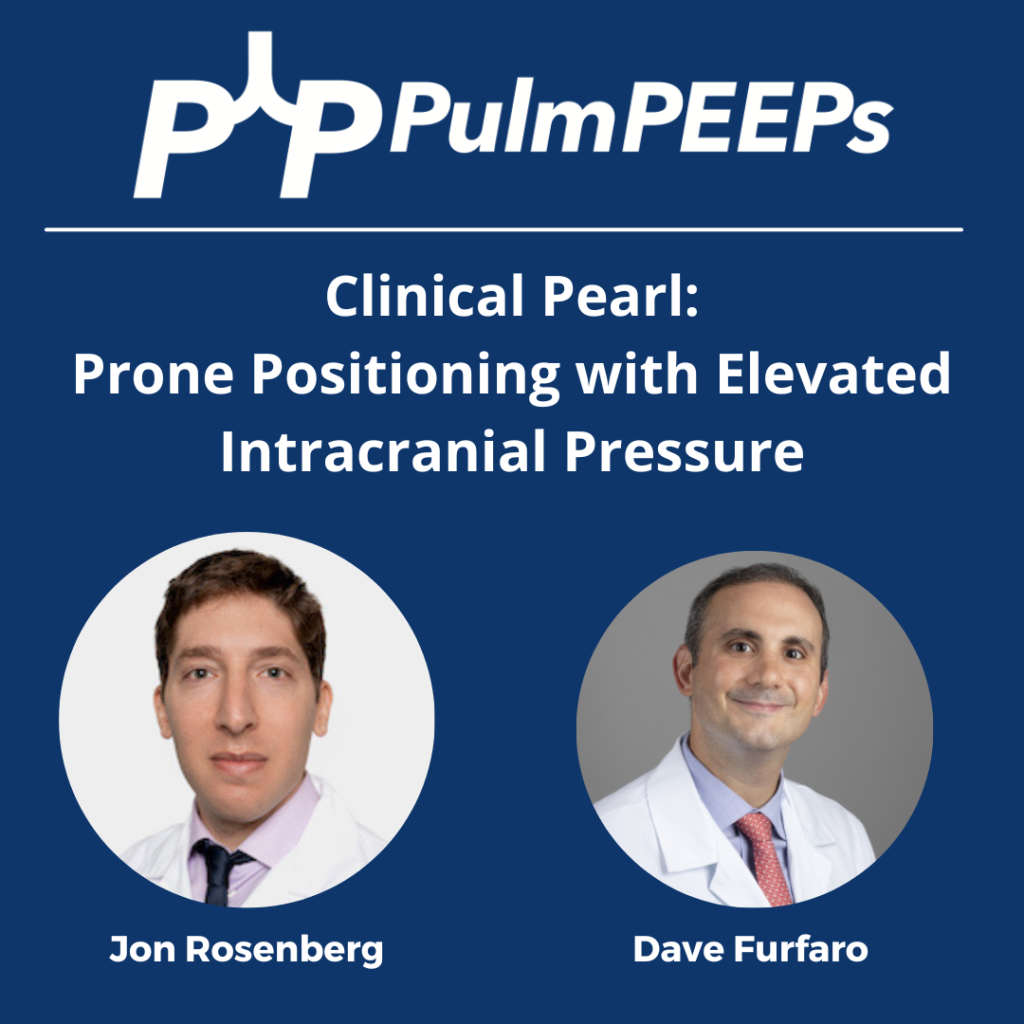Today we have a mini-episode / clinical pearl. We previously discussed the PROSEVA trial and the evidence for prone positioning in ARDS. In that trial, patients with elevated intracranial pressure (ICP) were excluded. We are joined now by Dr. Jon Rosenberg, a neuro intensivist, to discuss his how prone positioning can still be employed for patients with neurologic injuries and elevated ICP.

Meet Our Guest
Dr. Jon Rosenberg is an assistant professor of neurology and neurosurgery at Westchester Medical Center, New York Medical College. He’s also the associate program director of the Neurocritical Care Fellowship at Westchester Medical Center and a frequent contributor to the Neurocritical Care Society podcast.
Key Learning Points
- Elevated Intracranial Pressure (ICP) and Proning: A Common Misconception
- Elevated ICP is often considered a contraindication to proning, but this is more of a relative caution rather than an absolute contraindication.
- Many neuro ICUs have successfully proned patients with elevated ICP, particularly since the COVID-19 pandemic, when critical care units had to manage both respiratory failure and neurological conditions simultaneously.
- Patient Selection for Proning with Elevated ICP
- Most patients with elevated ICP can still be proned, including those with:
- Global cerebral edema (e.g., post-anoxic brain injury, liver failure)
- Focal lesions (e.g., traumatic brain injury, large ischemic strokes, intracerebral hemorrhage)
- Situations where proning might be more concerning:
- Severe hemodynamic instability (multi-pressor shock)
- Morbid obesity (e.g., >300 lbs), where physically flipping the patient is a major challenge
- Theoretical Concerns with Proning in Elevated ICP
- Loss of neurological exam access (sedation + flipped position makes pupil and motor exam difficult)
- Jugular venous compression (especially if the head is turned to one side)
- Cerebrospinal fluid (CSF) flow obstruction, depending on the lesion
- Risk of increased ICP if venous outflow is impaired or head positioning is not optimized
- Best Practices for Proning Patients with Elevated ICP
- Patients with invasive ICP monitors vs. without monitors:
- If possible, placing an ICP monitor (EVD or parenchymal bolt) before proning provides better guidance.
- Without a monitor, providers must rely on other practices like maintaining strict MAP goals and sodium targets, and indirect signs of increased ICP.
- Positioning considerations:
- Keep the head midline to prevent jugular venous compression.
- If head positioning is not neutral, place the dominant/internal jugular facing upward to maintain venous drainage.
- Maintain the head of the bed elevated even while prone (reverse Trendelenburg positioning).
- Hemodynamic management:
- Target a higher MAP (e.g., 70–75 mmHg, sometimes 75–80 mmHg) to ensure adequate cerebral perfusion pressure (CPP) if there is no ICP monitor
- Avoid hypotension, as MAP – ICP = CPP, and low MAP could critically reduce cerebral perfusion.
- A normal intracranial pressure is 7 – 15 mmHg
- The recommended CPP is between 60 – 70 mmHg
- Sedation & Sodium Management:
- Consider deep sedation (RASS -5) to reduce metabolic demand and intracranial blood volume.
- Consider keeping sodium >145 mmol/L prophylactically to mitigate brain swelling if no ICP monitor in place
- When to Reconsider Proning (i.e. when to supinate)
- If a patient’s ICP spikes significantly (e.g., from 20 to 60 mmHg) despite medical management (hypertonic saline, sedation, paralysis, etc.).
- If new signs of neurological deterioration emerge (e.g., changes in pupil exam once patient is repositioned).
- Hemodynamic instability that is unmanageable in the prone position.
- Literature and Future Considerations
- Small case series have demonstrated success in proning patients with traumatic brain injury (TBI) and aneurysmal subarachnoid hemorrhage.
- While more formal research is needed, the neurocritical care community has begun embracing proning for neuro patients, provided that proper precautions are taken.
Bottom Line
- Proning is not an absolute contraindication for patients with elevated ICP—it can be done safely with proper monitoring, patient selection, and precautions.
- Having an ICP monitor makes the process more controlled and allows clinicians to adjust treatment in real time.
- Key considerations: Maintain cerebral perfusion, optimize head positioning, monitor hemodynamics, and have a plan for reversing if ICP becomes unmanageable.
Podcast: Play in new window | Download
Subscribe: Apple Podcasts | Spotify | Amazon Music | Android | iHeartRadio | Podcast Index | RSS | More
